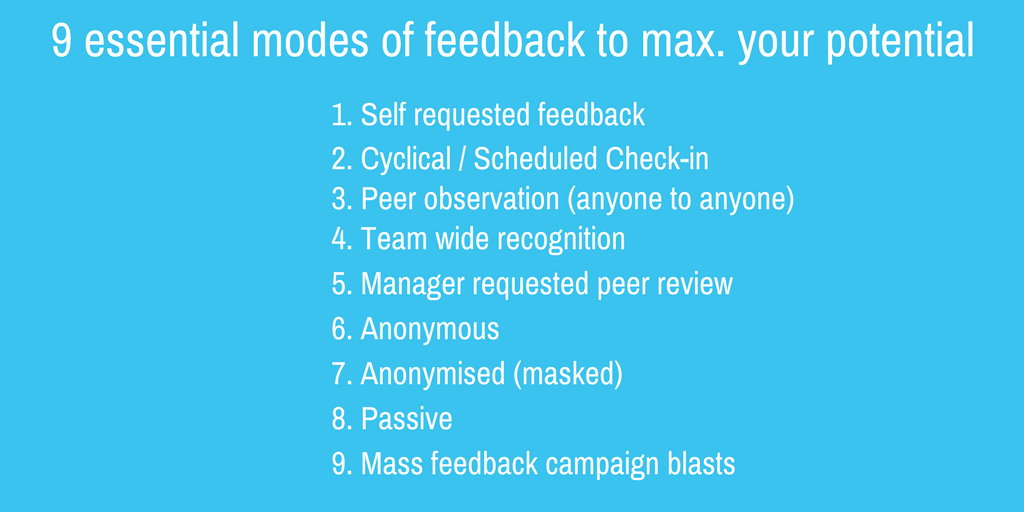
What happens when you pick your favourite flavour of feedback?
When we started Pay Compliment almost 4 years ago, the idea of getting feedback more frequently than once a year was new. It was enough of a treat for employees to get feedback more than annually, so it didn't really matter how that extra feedback came about and what container it was provided in.
Like most of the new real-time feedback platforms, we had a single scoop of real-time feedback given from peer to peer in a text box.
That was the only thing on the menu, all day every day.
For some people that's how they like it. Predictable. Straightforward. Nothing fancy. For others it was quickly limiting, and the potential of sharing frequent feedback was lessened because their experience of it became bland.
Feedback made to order
As founder sponsors of the Human Capital Institute conference for Performance Management Innovation we were lucky to hear the expert view of people like David Rock.
We heard that psychologically speaking feedback that you ask for yourself, picking the observers and the focus of their input, is far more effective than unsolicited observations of co-workers on topics of little interest to you (although for praise and recognition peer to peer feedback is still highly effective).
This led us to introduce the functionality to support self-requested feedback.
We discovered that self-requested feedback is the only way that certain employees (senior leaders and executives in particular) could get the performance signals they need. By showing some vulnerability, being seen as open, and giving permission for input, users of self-requested feedback have overcome the feedback famine they otherwise suffered from.
Loyalty card
Unsurprisingly, shifting mindsets from annual feedback cycles to frequent check-in's is a challenging change to make. Using data to measure the extent to which check-in's actually happen we found that soon after training and supervision concludes, optional participation and compliance drifts away.
Just like a loyalty card gets you back to the ice cream parlour, scheduled feedback with email reminders gets you back to the next feedback conversation by setting up the cadence/frequency that suits the leader and the employee as a check-in cycle.
Originally scheduled feedback was only available to managers, though now we have expanded its availability so that individuals can also set the pace of check-in's if their managers do not.
Familiar flavours with a cherry on top
So far we've looked at what we offer to improve performance management with more agile alternatives to annual reviews. Complete alternatives to annual reviews hasn't been what most customers have wanted though.
We found that despite the issues with annual reviews they do serve an important part in addition to an expanded diet of regular check-in's with managers, real-time feedback, and peer-to-peer recognition.
However, we found that we could not only match traditional 360 reviews but that we could improve upon it by empowering individuals and managers to initiate their own 360 reviews without needing HR to orchestrate (and pay a hefty price for) a centrally managed process.
We offer 'flows' that route reviews between the person being reviewed, reviewers and managers to achieve a 360 review for anyone in the organisation with reviewers that they or their manager select, at any time of the year to suit their particular circumstances.
Family time
Eating ice cream is better when the experience is shared, and so is receiving recognition as part of a team.
There's nothing more controversial than 'employee of the month' or league tables that result in a winner so that everyone else is a loser!
That's like taking the family to the store and only rewarding the favourite child.
We avoid comparison to others by keeping recognition and criticism private and we encourage collective appreciation for those times when everyone deserves it.
Shared feedback is like a family visit to get ice cream, everybody joins in. The resultant shared conversations are like tasting each others choices, creating shared memories, and enjoying a common bond.
Secret snacking
Now let's be honest there are times when we might not want to risk reprisals.
I'm thinking about the late night trip to the freezer when there's only one serve of cookie dough ice cream in the tub! Yes it's mine but you probably wanted it too!
With feedback and culture, the issue of reprisal is a whole lot more serious, and it's a key reason why people fear being open and honest in giving feedback and calling out bad behaviour.
To provide a safe platform for the reviewers and those being reviewed we offer 2 types of protection.
Anonymous feedback is the obvious approach, however, we can see a clear correlation between anonymous feedback and negativity so there are limitations; we always moderate anonymous feedback to protect the recipient, and of course, anonymous feedback doesn't allow for clarification or conversation.
Anonymised feedback is a better option. With anonymised feedback the identity of the contributor is known by the platform, but it is masked from other stakeholders in the feedback chain. This makes it good for culture assessments, manager reviews, whistleblowing and other sensitive scenarios where the contributor needs protection but their observation must be actionable.
Home delivery
Sometimes it's tough to get everyone's buy-in to do the same thing at the same time in the same place.
With remote work, shifts, contingent workers and so on, anything with a large reach that's all inclusive needs to be ultra-convenient like home delivery where the time, place and choices are left to me.
We satisfy this by being a 24*7 web application that sits beyond the four walls of any enterprise. Anyone can participate with any kind of device that has a web browser or the ability to send email.
That means there is little friction to engage.
That doesn't drive engagement though, it simply removes excuses or barriers.
What drives engagement is the campaigns that bring people to the screen. Just like email marketing brings people into stores (bricks and mortal and online), feedback campaigns are designed to bring people into performance conversations (in real life and online).
Oh, by the way
The one last way we enable feedback is passively. If you've seen the smiley face kiosk by the exit of the store, you have an idea what passive feedback is about.
In terms of performance management, passive feedback is about feedback enabling every employee touch point as an opportunity to get feedback. That's by including a link to your feedback page in your email signature, or adding Feedback ID's to your company directory, or putting feedback pages into people profiles on your intranet or a QR code to your feedback page on your business card or name badge. Every subscriber gets an individual feedback page and a feedback email address to offer as a means of providing passive feedback.
Getting a taste for it
We've learned that there are 9 modes of feedback that are necessary to make the change to a candid culture of in the moment and prescheduled feedback to drive better performance from everyday observations.

Any less than this and you risk not tailoring to individual tastes.
If you would like to learn how to roll this out from one flexible performance achievement platform we would love for you to contact us.
We'd also like to hear of your experiences in the comments below.
One more way that feedback is like ice cream
The other way that feedback is like ice cream is that both are highly effective at simulating the release of dopamine.
Dopamine is a neurotransmitter associated with anticipation of reward.
We use neuroscience to engineer our user experience to make sure that the exchange of feedback has the best chance of creating a reward response in the brain when traditionally it would present as a psychological threat.
Dopamine release is extremely effective in stimulating habits (or more strongly put addiction) and whilst we are not aiming for users of Pay Compliment to form addictions to it, we are aware that creating positive habits of noticing and attending to feedback is recognised as the key point of difference in behaviour of the highest performing CEO's.